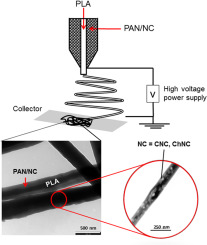当前位置:
X-MOL 学术
›
J. Membr. Sci.
›
论文详情
Our official English website, www.x-mol.net, welcomes your
feedback! (Note: you will need to create a separate account there.)
Coaxial poly(lactic acid) electrospun composite membranes incorporating cellulose and chitin nanocrystals
Journal of Membrane Science ( IF 8.4 ) Pub Date : 2017-12-01 , DOI: 10.1016/j.memsci.2017.09.033 Blanca Jalvo , Aji P. Mathew , Roberto Rosal
Journal of Membrane Science ( IF 8.4 ) Pub Date : 2017-12-01 , DOI: 10.1016/j.memsci.2017.09.033 Blanca Jalvo , Aji P. Mathew , Roberto Rosal

|
Abstract In this study, we used electrospinning to produce core-shell nanofibers of poly(lactic acid) as core and polyacrylonitrile/cellulose nanocrystals (CNC) or polyacrylonitrile/chitin nanocrystals (ChNC) as shell. Electrospun materials prepared at different nanocrystal concentrations were tested and assayed as microfiltration membranes. The coaxial membranes presented a maximum pore size in the 1.2–2.6 µm range and rejections > 85% for bacterial cells (0.5 × 2.0 µm) and > 99% for fungal spores (> 2 µm). The morphological and mechanical properties and the water permeability of the nanocomposite membranes were studied. The morphological characterization showed random fibers of beadless and well-defined core/shell structured fibers with diameter generally below the micron size with presence of secondary ultrafine nanofibers. Tensile strength and Young's modulus of elasticity improved with respect to coaxial membranes without nanocrystals with best mechanical properties achieved at 5 wt% CNC and 15 wt% ChNC loadings. The enhancement was attributed to the reinforcing effect of the percolating network of cellulose nanocrystals. Water permeability increased for all membranes loaded with nanocrystals with respect to the coaxial fibers without nanocrystals, the highest corresponding to ChNC composites with up to a 240% increase over non-loaded membranes. Composite membranes prepared with CNC in their shell were hydrophilic, in contrast with the hydrophobic PLA core, while coaxial fibers with ChNC were superhydrophilic. CNC membranes were negatively charged but ChNC originated neutral or positively charged membranes due to the contribution of deacetylated chitin structural units. Upon exposure to E. coli cultures, composite membranes containing ChNC showed a high antimicrobial action and were essentially free of bacterial colonization under strong biofilm formation conditions.
中文翻译:

含有纤维素和几丁质纳米晶体的同轴聚乳酸电纺复合膜
摘要 在本研究中,我们使用静电纺丝法制备了以聚乳酸为核、聚丙烯腈/纤维素纳米晶 (CNC) 或聚丙烯腈/甲壳素纳米晶 (ChNC) 为壳的核壳纳米纤维。以不同纳米晶体浓度制备的电纺材料作为微滤膜进行了测试和分析。同轴膜的最大孔径在 1.2–2.6 µm 范围内,细菌细胞 (0.5 × 2.0 µm) 的截留率 > 85%,真菌孢子 (> 2 µm) 的截留率 > 99%。研究了纳米复合膜的形态和力学性能以及透水性。形态特征显示无珠和明确定义的核/壳结构纤维的随机纤维,其直径通常低于微米尺寸,并存在次级超细纳米纤维。相对于没有纳米晶体的同轴膜,拉伸强度和杨氏弹性模量得到改善,在 5 wt% CNC 和 15 wt% ChNC 负载下实现了最佳机械性能。这种增强归因于纤维素纳米晶体渗透网络的增强作用。与没有纳米晶体的同轴纤维相比,所有装有纳米晶体的膜的透水性都增加,最高值对应于 ChNC 复合材料,比未装载的膜增加了 240%。与疏水的 PLA 核相比,在其壳中使用 CNC 制备的复合膜具有亲水性,而具有 ChNC 的同轴纤维具有超亲水性。CNC 膜带负电,但由于脱乙酰几丁质结构单元的贡献,ChNC 产生中性或带正电的膜。暴露于大肠杆菌培养物后,含有 ChNC 的复合膜显示出高抗菌作用,并且在强生物膜形成条件下基本上没有细菌定植。
更新日期:2017-12-01
中文翻译:

含有纤维素和几丁质纳米晶体的同轴聚乳酸电纺复合膜
摘要 在本研究中,我们使用静电纺丝法制备了以聚乳酸为核、聚丙烯腈/纤维素纳米晶 (CNC) 或聚丙烯腈/甲壳素纳米晶 (ChNC) 为壳的核壳纳米纤维。以不同纳米晶体浓度制备的电纺材料作为微滤膜进行了测试和分析。同轴膜的最大孔径在 1.2–2.6 µm 范围内,细菌细胞 (0.5 × 2.0 µm) 的截留率 > 85%,真菌孢子 (> 2 µm) 的截留率 > 99%。研究了纳米复合膜的形态和力学性能以及透水性。形态特征显示无珠和明确定义的核/壳结构纤维的随机纤维,其直径通常低于微米尺寸,并存在次级超细纳米纤维。相对于没有纳米晶体的同轴膜,拉伸强度和杨氏弹性模量得到改善,在 5 wt% CNC 和 15 wt% ChNC 负载下实现了最佳机械性能。这种增强归因于纤维素纳米晶体渗透网络的增强作用。与没有纳米晶体的同轴纤维相比,所有装有纳米晶体的膜的透水性都增加,最高值对应于 ChNC 复合材料,比未装载的膜增加了 240%。与疏水的 PLA 核相比,在其壳中使用 CNC 制备的复合膜具有亲水性,而具有 ChNC 的同轴纤维具有超亲水性。CNC 膜带负电,但由于脱乙酰几丁质结构单元的贡献,ChNC 产生中性或带正电的膜。暴露于大肠杆菌培养物后,含有 ChNC 的复合膜显示出高抗菌作用,并且在强生物膜形成条件下基本上没有细菌定植。









































 京公网安备 11010802027423号
京公网安备 11010802027423号